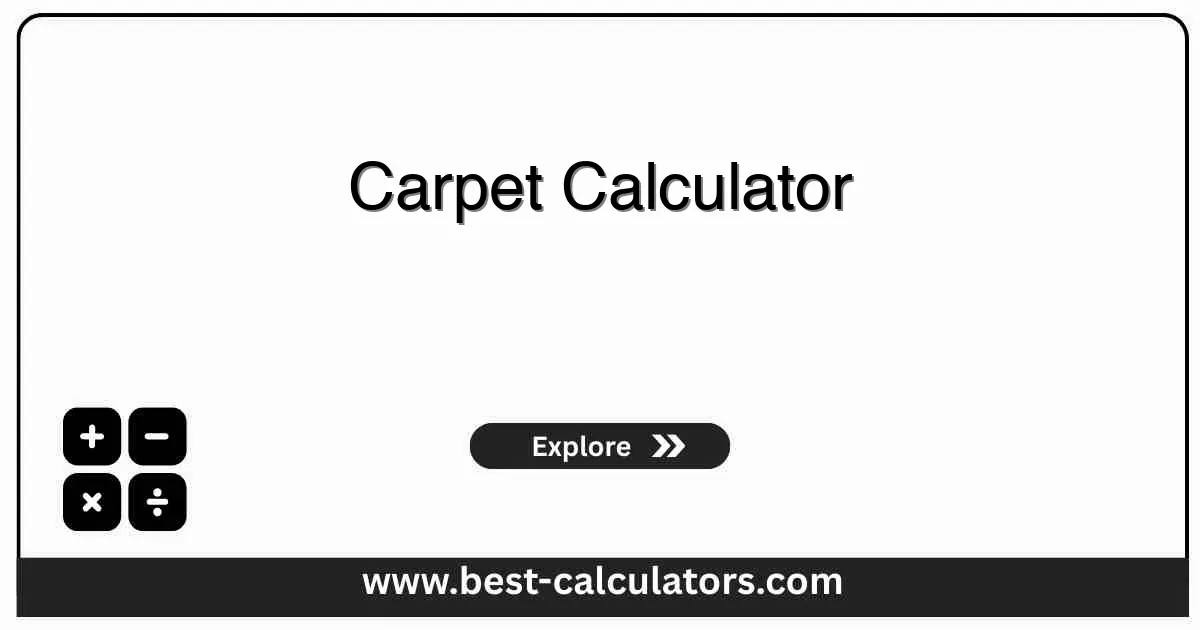Carpet Calculator - Estimate Materials & Installation Costs
Free carpet calculator to determine square footage, padding requirements, and total project costs for flooring installations
Carpet Calculator
Results
What is a Carpet Calculator?
A carpet calculator is a free construction tool that helps you estimate the amount of carpet and padding needed for your flooring projects. It calculates materials, costs, and installation requirements based on room dimensions and carpet specifications.
This calculator helps with:
- Material estimation - Calculate exact carpet and padding quantities
- Cost planning - Estimate total project costs including labor and materials
- Waste calculation - Account for cutting waste and pattern matching
- Installation planning - Determine labor requirements and project timeline
- Budget preparation - Plan flooring budgets with accurate estimates
Planning to paint walls after new flooring? Our Paint Calculator helps you estimate paint requirements and costs for complete room renovations.
For precise material measurements and lumber planning, use our Lumber Calculator to calculate board feet, linear feet, and costs for construction projects.
To determine concrete requirements for subfloor preparation, check our Concrete Calculator for accurate volume and cost estimates.
For flooring transitions and installation planning, explore our Window & Door Calculator to measure openings and plan installation around fixtures.
Types of Carpet
Berber
Loop-style carpet with textured surface. Durable and stain-resistant, ideal for high-traffic areas.
Plush
Soft, luxurious cut-pile carpet with smooth surface. Comfortable but shows footprints and vacuum marks.
Frieze
Twisted cut-pile carpet that hides footprints well. Durable and good for active families.
Textured
Multi-level cut-pile with varied surface texture. Hides dirt and wear patterns effectively.
Carpet Padding
Proper padding is essential for carpet performance and comfort:
Standard Padding
1/4 inch thick rebond padding for most residential applications.
Premium Padding
3/8 inch thick for extra comfort and better sound absorption.
Berber Padding
Denser padding specifically designed for loop and Berber carpets.
High-Density
1/2 inch thick for maximum comfort and durability in luxury applications.
How to Use This Carpet Calculator
Enter Room Dimensions
Input length, width, and number of rooms to calculate total area
Select Carpet Type
Choose your preferred carpet style and quality level
Choose Padding
Select appropriate padding type based on carpet and usage
Set Waste Factor
Choose appropriate waste percentage for your layout complexity
Enter Costs
Add labor, material, and additional costs for your area
Get Results
View material requirements and total project costs
Benefits of Using Carpet Calculator
- • Accurate Budgeting: Know exact material and labor costs before starting.
- • Material Planning: Order correct amounts to avoid shortages or excess.
- • Contractor Comparison: Verify installer estimates and ensure fair pricing.
- • Project Scheduling: Plan installation timeline and material delivery.
- • Quality Assurance: Ensure proper padding and material specifications.
Factors That Affect Your Carpet Installation
1. Room Shape Complexity
Irregular shapes, angled walls, and built-in features increase waste and installation time.
2. Stairs and Transitions
Stairs, different flooring types, and doorways require additional materials and labor.
3. Subfloor Condition
Uneven or damaged subfloors may need repair or leveling before installation.
4. Pattern Matching
Patterned carpets require extra material for pattern alignment and waste.

Frequently Asked Questions (FAQ)
Q: How do I calculate the square footage for carpet?
A: Measure length and width, then multiply. For irregular rooms, divide into rectangles and add areas together. Include closets and hallways.
Q: How much extra carpet should I order?
A: Add 10% for standard installations, 15% for complex layouts, and 20% for pattern matching. This ensures enough material for waste and future repairs.
Q: What is the difference between carpet rolls and tiles?
A: Rolls come in 12-15 foot widths measured in square yards. Tiles are pre-cut squares that snap together, offering easier installation and replacement.
Q: How much padding do I need under carpet?
A: Most residential carpet needs 1/4 to 1/2 inch padding. Berber carpets use denser 1/4 inch padding. Choose based on carpet type and usage.
Q: What's included in carpet installation costs?
A: Installation includes carpet, padding, tack strips, removal of old carpet, subfloor prep, and labor. Additional costs may apply for stairs and complex areas.
Q: How accurate are these carpet calculations?
A: These estimates provide a good starting point. Actual requirements may vary based on room complexity, pattern matching, and installation method.